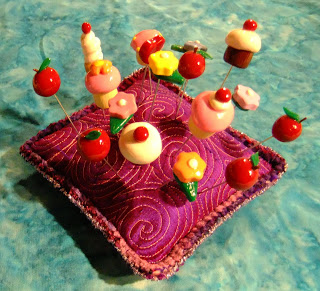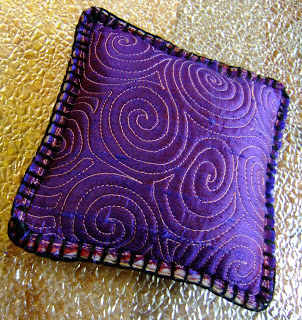Quilted Pincushion Tutorial
If you’re like me, chances are you have loads of quilted samples floating around your quilting room.
I restitched more than 50 designs from the project this past winter and all the original squares have just been sitting in a pile, waiting for me to figure out what to do with them. Until now!
 I created this simple little pincushion last week to showcase my Pin Toppers from Sew Craft Jess. I wanted a simple project that would use up a few squares I’ve already quilted so I wouldn’t have to piece something new.
I created this simple little pincushion last week to showcase my Pin Toppers from Sew Craft Jess. I wanted a simple project that would use up a few squares I’ve already quilted so I wouldn’t have to piece something new.
I also wanted to play with some of the decorative threads I’ve been saving for months, but never gotten around to using.
So let’s get started! Here’s what you’re going to need:
- 2 quilted squares measuring 4″ x 4″
- Walking Foot
- Polyester or wool batting scraps or fiberfill or trimmings from your last haircut
- 4-in-1 tool (optional, but helpful)
- Embroidery Floss
- Variety of Decorative threads
- Hand embroidery needle
Step 1 – Putting the pincushion together
With WRONG sides together and using your walking foot, stitch the two quilted squares together with a 1/4″ seam leaving about a 1″ gap on one side. Reinforce the stitching on either side of the opening by back-stitching.
Step 2 – Stuff the pincushion
Using the blunt point end of the 4-in-1 tool, stuff your pincushion with the batting or fiber fill.
Here’s a tip I learned from my Grandma years ago: next time you get a hair cut, ask if you can sweep up the trimmings. Save these and put them in your pincushions! The natural oils in your hair will keep your pins from rusting.
Step 3 – Seal the opening.
I stuffed my pincushion really full, but still managed to squish it under my foot enough to stitch the opening closed. Back stitch again to secure your threads completely on either side of the opening.
Step 4 – Binding with embroidery floss
Originally I’d planned to bind my pincushion with bias binding, but once I stuffed it, I realized it was going to be really hard to get it under my presser foot again.
Of course, if you really want to you could simply stitch on some bias binding by hand.
Or you could play with binding the edges with decorative threads!
The first step is to find some plain embroidery floss and a sharp embroidery needle. I’m using black floss, but it really doesn’t matter what you use as it will be completely covered by your decorative threads.
Start by tying a knot in one end, then insert your needle through the raw edge of the pincushion and bring it out the front so the knot and loose end are encased in the raw edges of the pincushion.
Take your first stitch, inserting your needle 1/4″ away and pulling it out the back. Don’t tighten the stitch completely. Instead insert your needle through the loop and pull it tight so the threads fully incase the raw edges of the pincushion.
Insert your needle into the front again 1/4″ away. From the back insert your needle through the loop, then tighten the floss until the raw edges are again encased.
I believe this is called a “Buttonhole Stitch” in embroidery, so if you have a good book on hand embroidery, look it up for a better diagram or picture of the stitch.
Here’s what it should look like when the full pincushion is encased with embroidery floss:
 Step 5 – Binding – Adding decorative threads
Step 5 – Binding – Adding decorative threads
Now select some decorative threads. The thicker and chunkier the threads, the better!
Again tie a knot and secure it in the raw edges of the pincushion. Working from the front, slide your needle behind one stitch of the embroidery floss and pull it through.
Insert your needle behind that same piece of floss a second time, pulling a loop of the decorative thread around so it loops around the embroidery floss, covering it completely.
Now insert your needle behind the next floss stitch, again looping it around a second time to completely cover the floss. Work around your whole pincushion this way.
Depending on the thickness of your decorative threads, you may have to do this several times. I went around the front and back 2 times each, then wound an extra length of metallic embroidery thread around the outer edge for a shiny finish.
Please don’t feel like you have to do this exactly as I’ve described. Bascially I used the embroidery floss as a skeleton for the decorative threads to be stitched on and wound around.
This way I never had to actually pull the decorative threads (which can be quite delicate) through the pincushion fabric itself. You could also experiment with adding braids, wider ribbons, and tassels to your pincushion as well!
So that’s it! This simple project can easily be completed in a few hours, it uses minimal supplies and is a great use of quilted fabric and decorative threads.
I think I’ll make up a few for my guild’s upcoming quilt show and donate them to the boutique of member created items. It’s a great way to help out the guild and play with pretty threads all at the same time!
Let’s go quilt,
Leah

This will be a great way to practice my FMQ with your designs. Thank you, Leah, for sharing both your quilting journey and your personal one.
Great idea! It always makes me feel bad throwing out my practice pieces. Wish I had thought of that.
What a neat idea. I have been trying to find the "right" pin cushion pattern for me and this may be it.